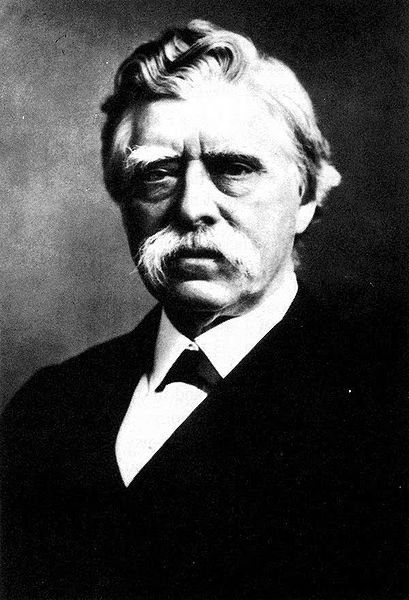<Back to Index>
- Inventor David Edward Hughes, 1831
- Composer Juan Morel Campos, 1857
- General of the Confederate States Army Edmund Kirby Smith, 1824
PAGE SPONSOR

David Edward Hughes (16 May 1831 – 22 January 1900), was a British scientist and musician. Hughes was co-inventor of the microphone, a harpist and a professor of music.
Hughes was born to Welsh parents in London in 1831 and emigrated to the United States at the age of seven. He was an experimental physicist, mostly in the areas of electricity and signals. He also invented an improved microphone, which was a modification of Thomas Edison's carbon telephone transmitter. He revived the term "microphone" to describe the transmitter's ability to transmit extremely weak sounds to a Bell telephone receiver. He invented the induction balance (later used in metal detectors) and in 1879 he transmitted and received radio waves using a detector made of carbon. Despite Hughes' facility as an experimenter, he had little mathematical training. He was a friend of William Henry Preece.
In 1879, years before Heinrich Hertz and sixteen years before Guglielmo Marconi had demonstrated the existence of radio waves, Hughes was already transmitting and receiving electromagnetic waves over several hundred metres. At the time his work failed to satisfy colleagues’ demands for scientific method and proofs and so Hughes didn't mention his work until a magazine article was published in 1889. James Clerk Maxwell's theories were not yet well received and Hughes' transmissions were wrongly assumed to be electromagnetic induction. His achievements went unrecognized for decades. Marconi knew Hughes through Preece and Lodge.
Hughes invented a printing telegraph system in the United States in 1855, and in less than two years, a number of small telegraph companies, including Western Union in early stages of development, united to form one large corporation — Western Union Telegraph Co. to carry on the business of telegraphy on the Hughes system. In Europe, Hughes’ Telegraph System became an international standard.
The first book - length biography of David Hughes, by Ivor Hughes and David Ellis Evans, was published in 2011 by Images From The Past.
Hughes came from a Welsh musical family. At only six years old, he is known to have played the harp to a very high standard. At an early age, Hughes developed such musical ability that he is reported to have attracted attention of Herr Hast, an eminent German pianist in America who procured for him a professorship of music at St. Joseph’s College in Bardstown, Kentucky.
He became one of the most highly decorated inventors of his time. Honors included a Grand Gold Medal in 1867 awarded at the Paris Exhibition, the Royal Society gold Medal in 1885, and The Albert Gold Medal, Society of Arts in 1897. For his numerous inventions and discoveries, especially the Printing Telegraph and Microphone, Napoleon III awarded him a Chevalier of the Legion of Honour awarding him Commander of the Imperial Order of the Legion of Honour. He also was awarded: the Order of Saints Maurice and Lazarus (Italy), the Order of the Iron Crown (Austria) which carried with it the title of Baron, the Order of Saint Anne (Russia), the Noble Order of Saint Michael (Bavaria), Commander of the Imperial Order of the Grand Cross of the Medjidie (Turkey), Commander of the Royal and Distinguished Order of Carlos III (Spain), the Grand Officer’s Star and Collar of the Royal Order of Takovo (Serbia), and Officer of the Order of Leopold (Belgium). He was elected a Fellow of the Royal Society in June 1880 and won their Royal Medal in 1885.
The Hughes Medal is awarded by the Royal Society of London in his memory "in recognition of an original discovery in the physical sciences, particularly electricity and magnetism or their applications". It was first awarded in 1902 to J.J.Thompson.